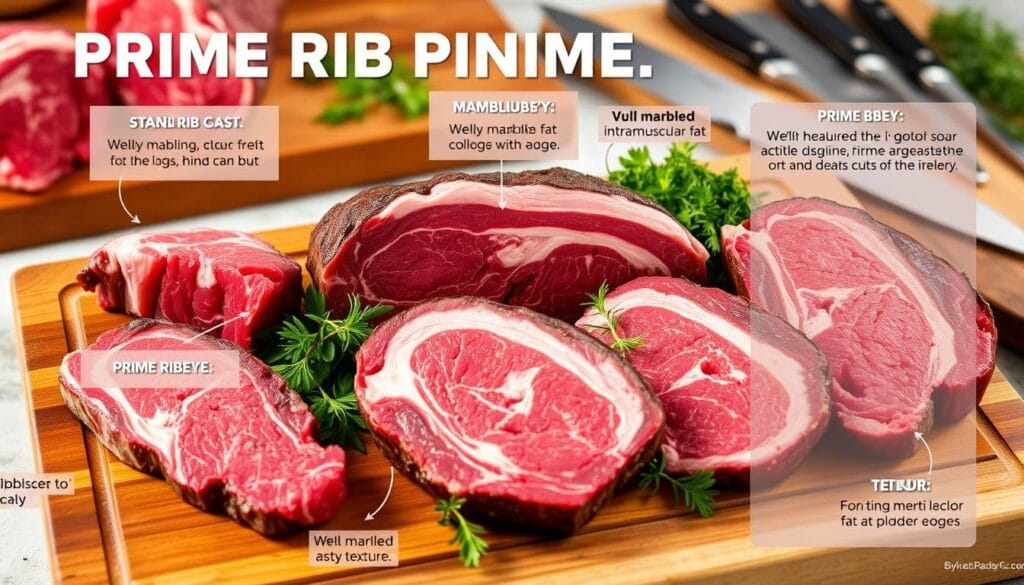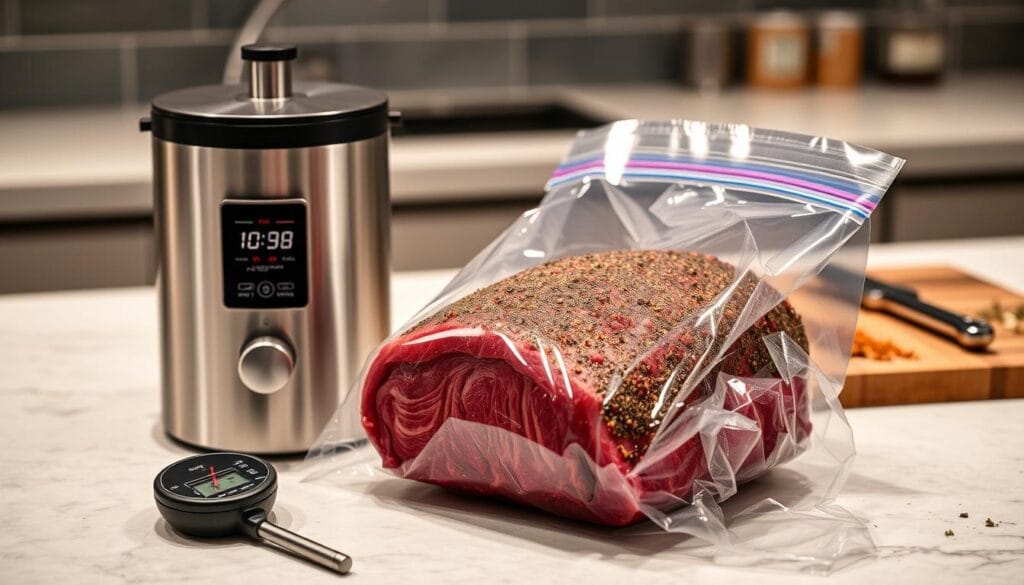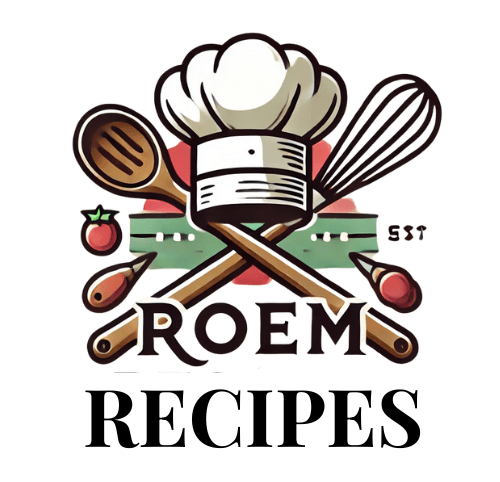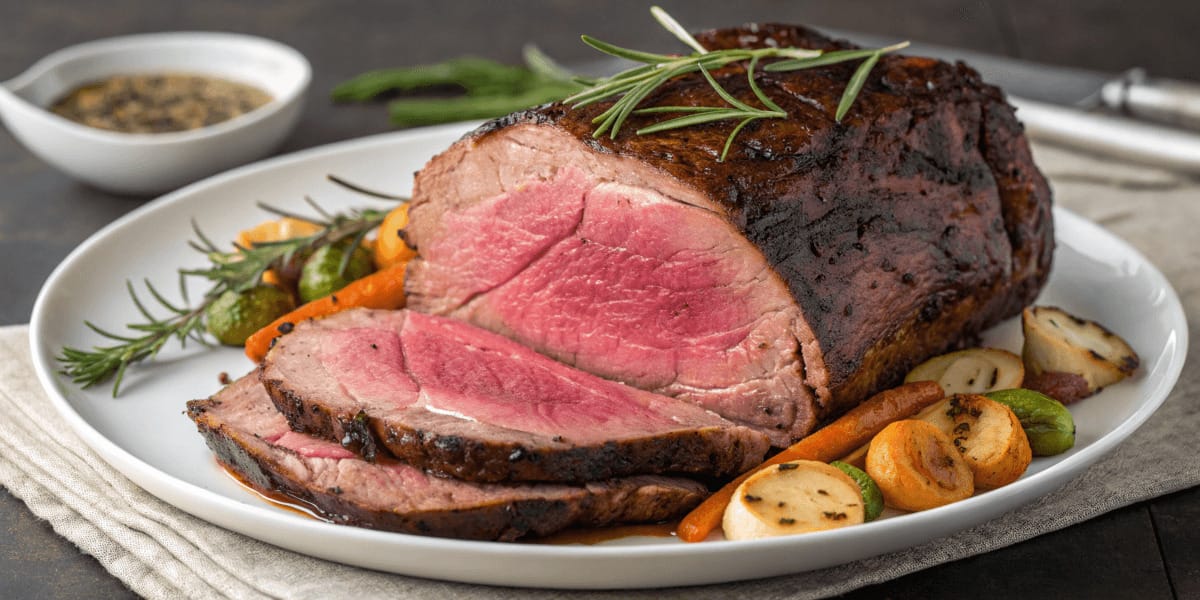Every home chef dreams of making the perfect prime rib roast. It’s a dish that wows guests. After 20 years of cooking, I found a secret: sous vide prime rib roast.
Imagine a prime rib that’s tender, juicy, and just right. Sous vide makes this possible. It takes away the guesswork of traditional roasting.
This recipe is a holiday favorite, earning 5-star reviews for years. Sous vide prime rib roast is special. It keeps meat moist and adds amazing flavor and texture.
In this guide, you’ll learn how to sous vide a prime rib roast. It’s perfect for both seasoned cooks and beginners. Sous vide prime rib roast will change how you cook premium meats.
Understanding Prime Rib: Selection and Quality Matters
Choosing the right prime rib for your sous vide dish is key. The meat’s quality greatly affects the taste and texture of your meal.

Prime vs Choice Grade Cuts
Understanding beef grades is important when picking your prime rib. The USDA grades meat into three categories:
- USDA Prime: Highest quality with lots of marbling
- USDA Choice: Good quality with some marbling
- USDA Select: Leaner cut with less fat
For the best sous vide rib eye roast, go for Prime or high-end Choice cuts. These ensure a melt-in-your-mouth experience. They also help determine the right cooking temperature for prime rib.
Bone-in vs Boneless Options
Prime ribs come in two main types:
- Bone-in: Adds flavor and protects the meat during cooking
- Boneless: Easier to carve and cooks more evenly
“The bone acts like a natural heat conductor, enhancing the meat’s overall flavor profile.” – Professional Butcher
Optimal Size and Weight Selection
When preparing your sous vide prime rib, keep these tips in mind:
- Estimate 0.75-1 lb of meat per person
- Choose well-marbled cuts for maximum tenderness
- Select roasts with a consistent fat cap of ¼ inch
Pro tip: For holiday gatherings or special occasions, choose a larger cut. It will serve multiple guests and offer great leftovers.
Essential Equipment for Sous Vide Prime Rib
To cook a sous vide prime rib roast, you need special equipment. This gear turns a simple meal into a memorable dining experience.

- Precision sous vide circulator
- Large water bath container
- Vacuum sealer or high-quality zip-top bags
- Digital meat thermometer
- Cast-iron skillet or culinary torch
When cooking a 3 lb roast sous vide, your tools are vital. A good sous vide machine keeps the temperature steady. This is key for a perfect medium-rare.
“Precision is the secret ingredient in sous vide cooking” – Professional Chef
Quality equipment makes a big difference in your sous vide prime rib. A reliable vacuum sealer keeps moisture in and cooking even. Your digital meat thermometer is crucial for checking internal temperatures.
- Pro Tip: Choose a water container large enough to fully submerge your roast
- Expert Recommendation: Select bags designed specifically for sous vide cooking
Remember, the right equipment turns a simple cooking method into a pro-grade technique. Your prime rib roast will be tender, flavorful, and perfectly cooked every time.
Preparing Your Prime Rib Roast for Sous Vide Cooking
Turning a prime rib roast into a masterpiece starts with careful prep. Learning the right techniques for sous vide cooking can make your dish stand out.
Pre-Seasoning Techniques
Seasoning is key for flavor in your prime rib roast. Begin by covering the meat with kosher salt and letting it sit at room temperature. This method helps the salt and heat spread evenly, making the roast better cooked slow or fast.
- Pat the roast dry with paper towels
- Make small slits for garlic slivers
- Lightly coat with olive oil
- Apply a strong dry rub for more flavor
Vacuum Sealing Tips
Sealing the roast properly is vital for sous vide success. You want to keep water out and ensure heat spreads evenly.
- Make sure the seal is tight and secure
- Remove as much air as you can from the bag
- Check for any air leaks or weak spots
- Use top-notch vacuum seal bags for sous vide
Temperature Equilibration
Letting your prime rib roast come to room temperature before sous vide cooking is key. It helps the heat distribute evenly, ensuring the meat is cooked perfectly.
“Patience in preparation leads to perfection on the plate.” – Culinary Wisdom
By using these prep steps, you’ll get a prime rib roast that’s tender, full of flavor, and cooked to perfection.
Prime Rib Roast Sous Vide Temperature Guide
Mastering the perfect sous vide prime rib requires precise temperature control. The cooking temperature greatly affects the taste, texture, and doneness of the meat.
When deciding on the cooking temperature for a prime rib roast, consider these key levels:
- Rare: 120-129°F (very red center)
- Medium Rare: 130-134°F (pink center, most popular)
- Medium: 135-144°F (light pink center)
- Medium Well: 145-154°F (slight pink center)
- Well Done: 155-164°F (minimal to no pink)
“The magic of sous vide is precise temperature control, ensuring your prime rib is perfectly cooked every time.” – Professional Chef
Most chefs recommend setting your sous vide water bath to 132°F. This temperature ensures a perfectly pink and tender prime rib with minimal risk of overcooking.
| Doneness Level | Temperature Range | Cooking Time |
|---|---|---|
| Medium Rare | 130-134°F | 6-8 hours |
| Medium | 135-144°F | 6-10 hours |
Remember, resting time affects the final temperature. A 10-15 minute rest can increase internal temperature by 5-7°F. So, plan your cooking time accordingly.
Step-by-Step Sous Vide Cooking Process
Learning to sous vide prime rib takes patience and precision. It’s a journey to a perfectly cooked roast. Let’s explore the key steps to turn your prime rib into a culinary masterpiece.
Initial Water Bath Setup
Setting up your water bath is key for a perfect sous vide prime rib. Choose a reliable sous vide machine, like the Anova precision cooker. Set the water to 132°F for a medium-rare roast.
Cooking Duration Guidelines
Timing is crucial when sous viding a prime rib. A 3 lb roast cooks for about 8 hours. Cooking can go up to 12 hours, but beware of meat breakdown after 10 hours.
| Roast Weight | Cooking Time | Temperature |
|---|---|---|
| 3 lb roast | 8 hours | 132°F |
| 5 lb roast | 10 hours | 132°F |
| 6 lb roast | 11 hours 15 minutes | 132°F |
Monitoring and Maintaining Temperature
Keeping the temperature steady is vital for a successful sous vide. Use a digital thermometer to check the water bath. Small temperature changes can affect your prime rib’s texture and doneness.
- Preheat water bath to 132°F
- Submerge vacuum-sealed prime rib
- Monitor temperature consistently
- Cook for recommended time based on roast weight
“Precision is the secret to sous vide perfection. Every degree matters.” – Culinary Expert
After cooking, take the roast out and let it rest for 15 minutes. This step allows juices to spread, making your prime rib moist and flavorful.
Perfect Searing Techniques After Sous Vide
Once your sous vide prime rib roast is cooked to perfection, it’s time to add a golden-brown crust. This step turns your prime rib into a dish with amazing flavor and texture.
To keep the juices in, searing is crucial. Here are three top ways to get that perfect crust:
- Cast-Iron Skillet Method
- Heat skillet until extremely hot
- Pat prime rib roast completely dry
- Sear each side for 1-2 minutes
- Culinary Torch Technique
- Use propane torch for precise browning
- Move torch continuously to prevent burning
- Aim for even golden-brown color
- High-Heat Oven Approach
- Preheat oven to 450°F
- Place roast on rack
- Broil for 4-6 minutes
“The perfect sear is the signature of a masterful prime rib roast sous vide preparation.”
Experts say to watch your roast closely while searing. You want a crispy outside without overcooking the inside.
| Searing Method | Time | Temperature | Difficulty |
|---|---|---|---|
| Cast-Iron Skillet | 1-2 minutes per side | High (500°F) | Medium |
| Culinary Torch | 2-3 minutes total | Direct flame | High |
| Oven Broil | 4-6 minutes | 450°F | Low |
Success with sous vide prime rib roast comes from patience and precision. Each method has its own benefits. Pick the one that fits your cooking style and kitchen.
Crafting the Perfect Prime Rib Seasonings and Rubs
Creating a great sous vide rib eye roast starts with the right seasoning. The perfect mix of herbs and spices can make your prime rib stand out. The sous vide method ensures your meat is full of flavor.
Seasoning your prime rib is an art. Professional chefs know that the right blend can bring out the meat’s natural taste.
Classic Herb Combinations
Traditional herb blends are a timeless choice for seasoning prime rib:
- Fresh rosemary
- Dried thyme
- Sage leaves
- Kosher salt
- Freshly ground black pepper
Garlic and Butter Infusions
Add depth to your sous vide rib eye roast with strategic garlic insertions. Make small slits in the meat and put in thinly sliced garlic cloves. This method lets the flavors soak deep into the meat during slow cooking.
“The secret to an incredible prime rib is letting flavors deeply integrate with the meat.” – Professional Chef
Contemporary Spice Blends
Modern cooking brings new flavors:
- Smoked paprika
- Ground cumin
- Espresso powder
- Cracked black pepper
- Dried herb mixtures
| Seasoning Type | Flavor Profile | Best Used With |
|---|---|---|
| Classic Herb Blend | Traditional, Earthy | Classic Roasting |
| Garlic Infusion | Intense, Aromatic | Sous Vide Cooking |
| Contemporary Blend | Bold, Complex | Adventurous Palates |
When cooking prime rib sous vide, slow cooking is key. Try different seasonings to find your favorite.
Serving and Presentation Tips
Presenting your sous vide prime rib is an art. It turns your dish into a memorable meal. The secret is to let the meat rest and slice it carefully. This shows off the tender meat from sous vide cooking.
After searing your prime rib, follow these key presentation tips:
- Let the prime rib rest for 15-20 minutes before carving
- Remove any kitchen twine carefully
- Use a sharp knife to slice against the grain
- Cut slices about 1/2 inch thick
Your sous vide prime rib needs a beautiful presentation. Here are some elegant serving ideas:
- Place slices on a large, warm platter
- Garnish with fresh rosemary or thyme sprigs
- Drizzle with au jus or herb-infused olive oil
- Serve right away to keep it warm and tender
“The visual appeal of a perfectly sliced prime rib is just as important as its flavor.” – Professional Chef Recommendation
When serving your prime rib, timing and temperature are key. Use a meat thermometer to check the temperature. The USDA suggests these internal temperatures:
- Rare: 125°F
- Medium-rare: 135°F
- Medium: 145°F
- Medium-well: 150°F
- Well-done: 160°F
Mastering these serving and presentation tips will make your sous vide prime rib unforgettable.
Complementary Sauces and Side Dishes
Improving your sous vide prime rib roast is more than just cooking it right. The right sauces, sides, and wines can make your meal unforgettable. Let’s look at some tasty options that will make your prime rib roast stand out.
Traditional Au Jus
The classic au jus is a must with your sous vide prime rib roast. Since sous vide cooking doesn’t give you pan drippings, you’ll need to make a rich beef broth sauce. Focus on deep, rich flavors that match the meat’s softness.
- Use high-quality beef broth
- Add roasted beef trimmings for intensity
- Season with fresh herbs
Horseradish Cream
No prime rib is complete without a tangy horseradish cream. This quick 5-minute sauce adds a zesty kick to the rich meat. Here’s a simple recipe:
- 1/2 cup sour cream (or Greek yogurt)
- 2 tablespoons prepared horseradish
- 1 teaspoon Dijon mustard
- Fresh chopped chives
- Salt and pepper to taste
Brands like Reese, Gold’s, and Zatarain’s have great prepared horseradish for this sauce. Remember, a well-made sauce can make your meal even better.
Wine Pairing Suggestions
Choosing the right wine can turn your sous vide prime rib roast into a gourmet meal. Full-bodied red wines are perfect for balancing the meat’s rich flavors:
- Cabernet Sauvignon
- Syrah
- Pinot Noir
- Merlot
These wines have bright acidity that complements the roast’s intense taste. Tip: Let your wine breathe for 30 minutes before serving to enhance its flavor.
Before wrapping up, don’t miss exploring more ways to elevate your prime rib expertise! Check out our guide on Mastering the Art of Grilled Prime Rib Roast: A Flavorful Feast for outdoor cooking enthusiasts. Curious about sourcing your prime rib? Learn everything you need to know with our detailed article on Costco Prime Rib Roast. If you’re wondering how prime rib compares to ribeye, our in-depth comparison of Prime Rib vs. Ribeye Roast will help you decide which cut best suits your next feast.
Conclusion
Learning to cook sous vide prime rib makes your home cooking feel like a fancy restaurant meal. You’ll get a dish that’s sure to wow anyone who tries it. The sous vide method proves that slow cooking is the way to go for perfect results.
Using sous vide for prime rib brings out the best in this high-quality beef. Cooking it at 120°F to 130°F makes it tender and full of flavor. The slow cooking also makes the meat’s fat melt, giving it a unique texture that fast cooking can’t match.
Adding a high-heat sear to your sous vide prime rib takes it to the next level. This step keeps the meat juicy and adds a delicious crust. It makes your prime rib truly special, whether it’s for a special dinner or just to try something new.
Patience and careful attention are crucial. Choosing the right USDA Prime cut and letting it rest properly are key. By following these steps, you’ll create a prime rib that’s as good as any steakhouse.


2 thoughts on “Mastering the Perfect Prime Rib Roast with Sous Vide”